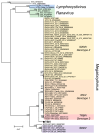Genomic Sequence of the Threespine Stickleback Iridovirus (TSIV) from Wild Gasterosteus aculeatus in Stormy Lake, Alaska
- PMID: 39599778
- PMCID: PMC11598847
- DOI: 10.3390/v16111663
Genomic Sequence of the Threespine Stickleback Iridovirus (TSIV) from Wild Gasterosteus aculeatus in Stormy Lake, Alaska
Abstract
The threespine stickleback iridovirus (TSIV), a double-stranded DNA virus, was the first megalocytivirus detected in wild North American fishes. We report a second occurrence of TSIV in threespine stickleback (Gasterosteus aculeatus) from Stormy Lake, Alaska, and assemble a nearly complete genome of TSIV. The 115-kilobase TSIV genome contains 94 open reading frames (ORFs), with 91 that share homology with other known iridoviruses. We identify three ORFs that likely originate from recent lateral gene transfers from a eukaryotic host and one ORF with homology to B22 poxvirus proteins that likely originated from a lateral gene transfer between viruses. Phylogenetic analysis of 24 iridovirus core genes and pairwise sequence identity analysis support TSIV as a divergent sister taxon to other megalocytiviruses and a candidate for a novel species designation. Screening of stickleback collected from Stormy Lake before and after a 2012 rotenone treatment to eliminate invasive fish shows 100% positivity for TSIV in the two years before treatment (95% confidence interval: 89-100% prevalence) and 0% positivity for TSIV in 2024 after treatment (95% confidence interval: 0 to 3.7% prevalence), suggesting that the rotenone treatment and subsequent crash and reestablishment of the stickleback population is associated with loss of TSIV.
Keywords: B22; Gasterosteus; iridovirus; megalocytivirus; threespine stickleback.
Conflict of interest statement
The authors declare no conflicts of interest.
Figures





References
-
- Inouye K., Yamano K., Maeno Y., Nakajima H., Matsuoka M., Wada Y., Antimachi M. Iridovirus Infection of Cultured Red Sea Bream. Pagrus Major. Fish Pathol. 1992;27:19–27. doi: 10.3147/jsfp.27.19. - DOI
Publication types
MeSH terms
Substances
Associated data
- SRA/PRJNA1156815
- Actions
- Actions
Grants and funding
LinkOut - more resources
Full Text Sources

